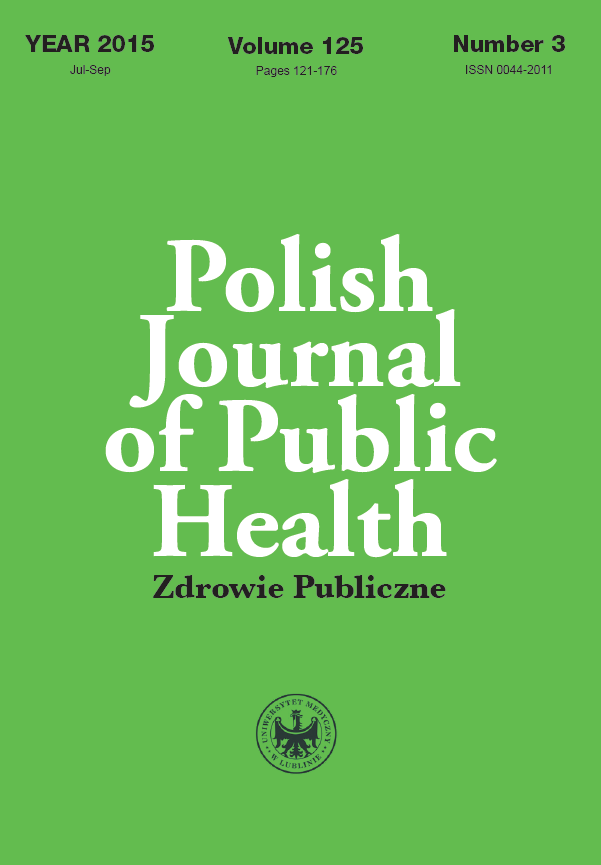Pregnant women suffering from uterine fibroids
DOI:
https://doi.org/10.1515/pjph-2015-0047Keywords:
uterine fibroids, pregnancy, womenAbstract
Introduction. Uterine fibroids are the most frequent benign tumors affecting sexual organs in women. It is estimated that they affect 20% of the female population, with the frequency in pregnant women ranging between 0.1-5%. In spite of the progress in the field of medicine, the actual cause of uterine fibroids has yet to be discovered.
Aim. Analysis of the recent methods of dealing with uterine fibroids during pregnancy.
Material and methods. A review of literature about dealing with pregnant, lying-in and parturient women suffering from uterine fibroids.
Results. The research studies by Aydeniz, Vergani, Rice showed that cesarean sections are much more frequent in pregnant women with uterine fibroids than in control group (52.9% vs 27.9%; 23% vs 12%; 35.1% vs 21.5%). However, it was shown that the rate of cesarean sections was much higher in women with uterine fibroids located in the lower part of the uterus than in the fundus uteri (respectively 39% and 18%). Also, the rate increased when the diameter of the fibroid exceeded 5 cm, unlike in case of those smaller than 5 cm (respectively 35% and 17%).
Conclusions. 1.The number of cesarean sections in women with uterine fibroids is higher than in control group. 2.The frequency of cesarean sections in pregnancies with uterine fibroids depends on their position and size. 3.There is no relationship between the number of complications and the amount of fibroids in pregnant women. 4.There is no agreement concerning the recommendations for removing the fibroid during cesarean section.
References
1. Woytoń J, Tomiałowicz M, Florjański J. Mięśniaki macicy w ciąży. Ginekol Położ. 2002;73(4):301-6.
2. Rasmussen KL, Knudsen HJ. Effect of uterine fibromas on pregnancy. Ugeskr Laeger. 1994;156:7668-70.
3. Roberts WE, Fulp KS, Morrison JC, Martin JN Jr. The impact of leiomyomas in pregnancy. Aust NZ J Obest Gyn. 1999;39(1):43-7.
4. Reroń A, Jaworski A, Pośpiech K. Mięśniaki macicy u kobiet ciężarnych. Perinatol Neonatol Ginekol. 2009;2(2):109-12.
5. Rein M, Barbieri R, Friedman A. Progesterone: A critical role in the pathogenesis of uterine myomas. Am J Obstet Gynecol.1995;172:4-8.
6. Vij U. Progestin and antiprogestin interactions with progesterone receptors in human myomas. Int J Gynecol Obstet. 1990;31:347-53.
7. Parazzini F, La Vecchia C, Negri E, et al. Epidemiologic characteristics of women with uterine fibroids: a case control study. Obstet Gynecol. 1988;72:853-7.
8. Silva PD, Sloane KA. Uterine leiomyomata: an overview. The Female Patient. 1992;17:49-56.
9. Zaloudek C, Norrsis HJ. Mesenchymal tumours of the uterus. In: RJ. Kurman (ed). Blaustein s Pathology of the female Genital Tract. 4 end. New York, NY: Springer Verlag, Inc; 1994. p. 487-528.
10. Cramer SF, Patel A. The frequency of uterine leiomyomas. Am J Clin Pathol. 1990;94:435-8. ( Level II-3).
11. Reroń A, Huras H. Etiopatogeneza mięśniaków macicy i ich wpływ na płodność i przebieg ciąży. Ginekol Położ. 2008;2(8):49-57.
12. Ross RK, Pike MC, Vessey MP, et al. Risk factors for uterine fibroids: reduced risk associated with oral contraceptives BMJ. 1986;293(6543):359-62.
13. Stewart EA. Uterine fibroids. Lancet. 2001;357:293-8.
14. Buttram VC Jr, Snabes MC. Indications for myomectomy. Semin Reprod Endocrinol. 1992;10:378-89.
15. Exacoutson C, Rosati P. Ultrasound diagnosis of uterine myomas and complications in pregnancy. Obstet Gynecol. 1993;82:97-101.
16. Zacur HA, Alvarez Murphy A, Tulandi T. Mięśniaki macicy postępy w diagnostyce i terapii. Ginekol po Dyplomie. 2000;2:10-9.
17. Wittich AC, Salminem Er, Yancey MK, Markenson GR. Myomectomy during early pregnancy. Mil Med. 2000;165(2):162-4.
18. Derwich K, Pawelczyk L, Opala T, Pisarski T. Mięśniaki macicy. Medipress Ginekol. 1996;2:6-13.
19. Rossati P. The volumetric changens of uterine myomas in pregnancy. Radiol Med (Torino). 1995;90:269-71.
20. Rossati P, Exacoustos C, Mancuso S. Longitudinal evaluation of uterine myoma growth during pregnancy. A sonographic study. J Ultrasound Med. 1992;11:511-5.
21. Rice JP, Kay HH, Mahony BS. The clinical significance of uterine leiomyomas in pregnancy. Am J Obest Gynecol. 1989;160:1212-6.
22. Rock JA, Thompson JD. Leiomyomata uteri and myomectomy. In: The Lindes Operative Gynecology.8 ed. Philadelphia, Pa: Lippincott-Raven; 1997. p. 731-3.
23. Aydeniz B, Wallwiener D, Kocer C, et al. Der Stellenwert myombedingter Komplikationem in der Schwangerschaft. Eine vergleichende Analyse von Schwangerschaftsverlaufen mit und ohne Myomerkrankurg.Geburtshilfe Neonatol. 1998;202:154-8.
24. Mollica G., Pittini L, Minganti E, et al. Elective uterine myomectomy in pregnant women. Clin Exp Obstet Gynecol. 1996;23(3):168-72.
25. Fruscella L, Ciaglia EM, Danti M. Vitamin E in the treatment of pregnancy complicated by uterine myoma. Minerva Ginecol. 1997;49:175-9.
26. Vergani P, Ghidini A, Strobelt N, et al. Do uterine leiomyomas influence pregnancy outcome? Am J Perinatol. 1994;11(5):356-8.
27. Febo G, Tessarolo M, Leo L, et al. Surgical management of leiomyomata in pregnancy. Clin Exp Obstet Gynecol. 1997;24(2):76-8.
Downloads
Published
Issue
Section
License
Copyright (c) 2015 Polish Journal of Public Health

This work is licensed under a Creative Commons Attribution-NonCommercial-NoDerivatives 3.0 Unported License.


